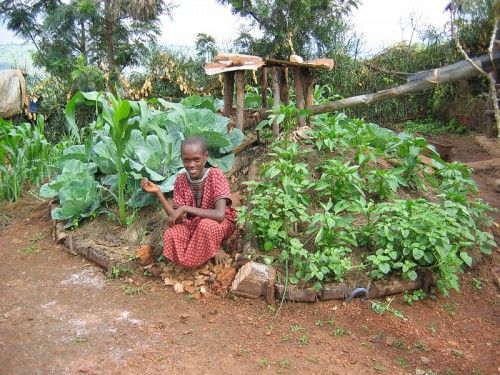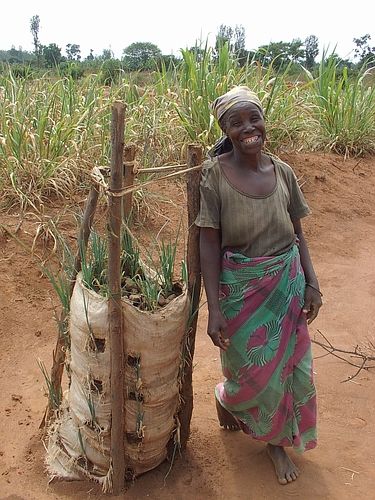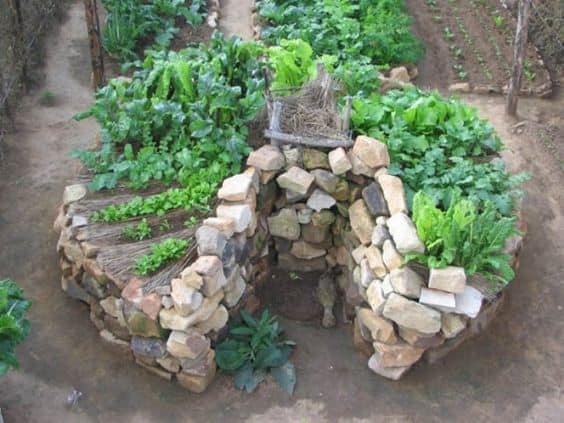My husband and I are hotly debating our planned vegetable garden addition. We are more than doubling its size, and the controversy surrounds the beds. Currently, we have (8) 4′ x 4′ and (2) 8′ x 4′ cedar beds that we got locally from this great place in western Massachusetts. The beds are charming – using a colonial peg system to hold them together rather than nails. But now I am considering something more like African keyhole gardens.

I think we should simply double what we have; it will keep a uniform, tidy look and be easy to accomplish. My husband (being more cost-conscious), however, disagrees; he wants to build raised beds using hessian (that’s British for burlap) sacks. He saw something once like this and thought it was a great idea. I think it will last about one season before rotting away, leaving us with a pile of whatever we fill it with. I think the answer is obvious, but the debate rages on.

As in many of these types of discussions, where a winner and a loser may never be definitively decided, I am wondering if perhaps a modified solution might be in order.
The reason for raised beds is that we have a lot (a. lot.) of rocks in our soil. They just keep percolating to the top.
There is a cluster of world-renowned seismologists that live down the road. They were moved here by Harvard University because the hill, atop which my house sits, is actually formed by a solid piece of ledge that interestingly extends very far into the core of the earth. Apparently, only one other place on earth shares this level of ledge depth. Seismologists think it is cool and interesting enough to make them gather. I, however, find the visual image of the rocks yet to rise daunting.
We just try not to deal by putting rock-free soil on top. But maybe this is being too lazy (though the thought of all the work exhausts me). And to be honest, I struggle with moving large amounts of topsoil and paying for truckloads of something I already have in spades.
So, I am thinking about building a few Keyhole gardens and Bag gardens, which are being used in Africa to help gardeners grow with minimal water.

The Keyhole Vegetable bed is a raised bed. It’s about 1m (3′6″) high, and the outer bed, where the vegetables are growing, slopes down from a central hollow column. There’s an access path to the column (giving the bed a “keyhole” shape viewed from above), and inside it is what amounts to a compost bin, held in with hessian. You fill it with kitchen waste, stable manure, grass clippings – whatever you’d put on your compost heap. Africans tip on water saved from washing up.
The idea is that the water will drain through and take all the nutrients with it. It feeds from below the topsoil, so everything’s coming up from underneath rather than watering on the surface and all the water evaporating. In Africa, this garden will feed a family of six through the three-month dry period, when crops in the fields simply dry out.
Similarly, the idea of a bag garden is that you can grow more vegetables in a smaller space. Hessian sacks are used and are filled with a core of stones surrounded by compost. The central column keeps the water from getting stuck in the top layers and helps it filter all the way through. That means even veg planted through pockets cut in the bottom of the bag get enough water. To get the column into the centre of the bag (or pot) take a plastic drinks bottle and cut off the neck and base, giving you a plastic tube. Put the tube in the center of your pot and fill it with stones. Pack the compost around it, lift the tube up, leave the stones in the soil, and repeat until you get to the top of the pot. It is like a rudimentary strawberry pot. I have stones…plenty to fill the bag and plenty more to build keyhole gardens — but the labor…
So I am curious: am I wrong about the hessian/burlap? I quite like the look of the tall bag gardens and am willing to give it a try, but really, what about rot? Hmm…. who’s got an opinion? Am I right, or is my husband?
North Americans can purchase premade keyhole garden kits here. (USA)
Canadians can purchase Keyhole Garden Kits through Walmart Canada.
(the above are affiliate links)
There is burlap from plant material and burlap made of plastic. Some burlap is biodegradable, some is less so. Rotting would depend what the fabric is made of, finishing chemicals, and exposure to sun and water. Hemp burlap in my back yard might last a growing season, but it is likely to come apart at the worst moment – yank on your first harvestable and the bed collapses?
I love the keyhole idea, maximizes surface of plantable area to path- also conserves water as you point out. Permaculture folks have the keyhole design stuff worked out- maximizing edges through curves and stacking to mimic nature’s tendency to support layers of growth. Your bed edges could be a way to use the wood you’ve felled this winter, rochelle. check out some of the regenerative/permaculture design sites…http://www.regenerativedesign.org/
http://regenerativedesigngroup.com/?page_id=4
for some inspiration.
Good luck with your spring garden endeavors!
Louise
I think a keyhole garden would be a magnificent addition to your already quite exquisite garden. Thanks for linking to our images of African Bag Gardens by the way.
Gardening guru Carol Klein is launching our new ‘Seeds of Hope’ campaign this Spring to get people outside and growing their own – in Bag Gardens!
This Spring, each kit comes with seeds of Hope (Beetroot), Health (French Beans) and Harmony (Salad Leaves), representing our life transforming work. You’ll also get a hessian sack, full instructions more tips and a fun window sticker.
I would love to hear how the process goes but if you are still looking at kits then you can take a look here: http://www.sendacow.org.uk/news-bag-gardens
Burlap? Only if you are growing potatoes. I don’t think burlap is good for more than one season anywhere. The ones shown in Africa are probably re-purposed feed bags or some such.
If the burlap they are using is not made of plastic, then I would guess that it lasts longer in Africa due to the dry conditions. I would think that non-plastic burlap would rot out much faster where conditions are far more damp.
What about using stacked used car tyres with holes cut out suitable for whatever veg you are growing they take years todegrade andarealsobrilliant for home potato cropping
hi!,I love your writing very so much! share we be in contact more
about your article on AOL? I need an expert on this house to
solve my problem. Maybe that’s you! Taking a look ahead to look
you.